Edition Details
Back in the middle of winter, when we set our sites on printing boxes in Europe this spring, we cast a wide net. But we were pretty certain that we wanted to have a least one stop in Italy, a country we’d both wanted to return to for some time.
Early in March Lisa sent in inquiry to Two Cents Press in the small Tuscan village of Serrazzano. She started:
With our creative juices now flowing, we are turning to adventure! We’re planning some travel in Europe in late April and we’d very much like to design and print a few editions while on the road.
Our dream is to find a printmaker who’d love to teach us some new things, and create together. We plan to share our overseas boxes with people we encounter on the rest of our travels. We’re willing to pay for training, materials and/or print shop rental.
Are you that printmaker of our adventure dreams?
If our plans excite you, we’d love to hear from you this week with a simple expression of your openness to explore the possibilities.
Two Cents Press is the brainchild of visual artist and printmaker Franco Marinai, and architect Anna K. Thorsdottir; just three hours later we received a reply from Franco:
Thanks for reaching out to us with your interesting and exciting project. We would be happy to work with you and support your creative endeavor sharing with you our printmaking skills.
What followed was some WhatsApp back-and-forth and Zoom-tour with Franco of the printing workshops. On March 17, we finalized arrangements for a residency from April 25 to 30, 2024.
We’d spent a good chunk of the week before arriving in Serrazzano in the Dutch town of Hilversum, printing at Grafisch Atelier Hilversum with Roy Scholten, so we’d already had some notion of what a residency might look and feel like, but, really, we had no idea what we’d find in Serrazzano.
Travel to Serrazzano
From Hilversum we travelled to Utrecht, where we caught an overnight train to Basel, Switzerland, and then a train onward, through the Alps, to Milan. In Milan we rented a car at the train station, spent night in a suburban hotel, and then made our way south to Tuscany, stopping for a night in Lucca (inspired by our friend Ton’s description of time there with his partner, our friend Elmine), and a quick nip into Pisa.
We arrived in the village of Serrazzano late in the afternoon of April 25, winding our way through the village up to Two Cents’ location in the historic heart.
We checked into our spacious apartment, above the printmaking shop; the views out our apartment windows confirmed our decision to print in Tuscany: the countryside was stunning.
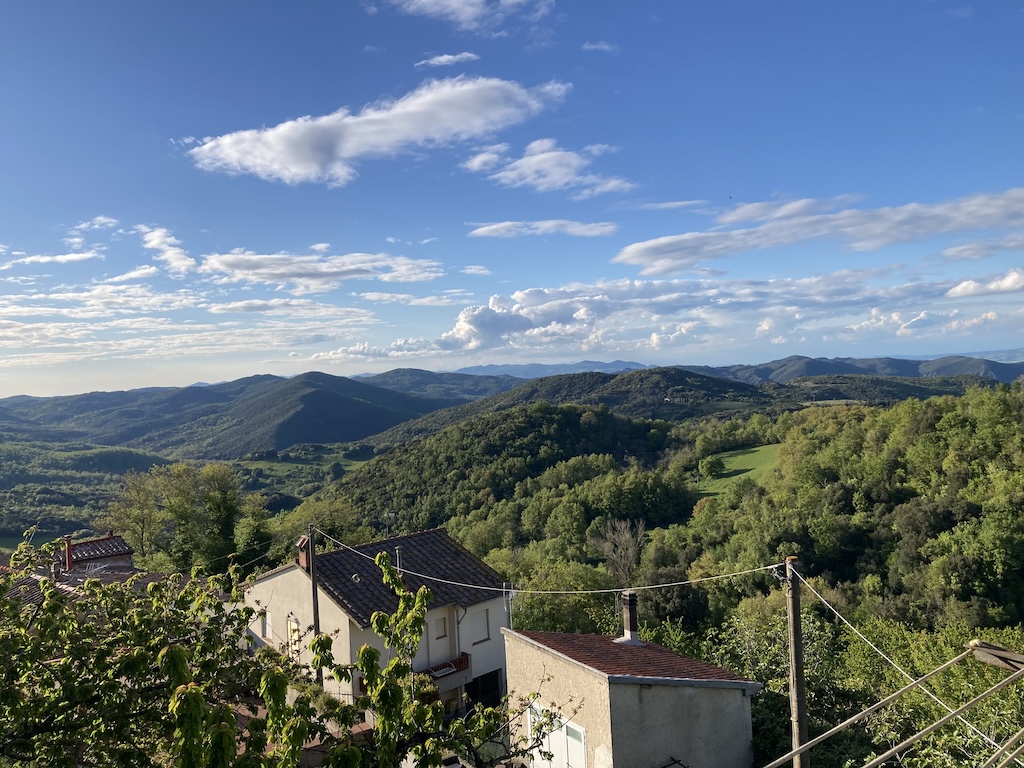
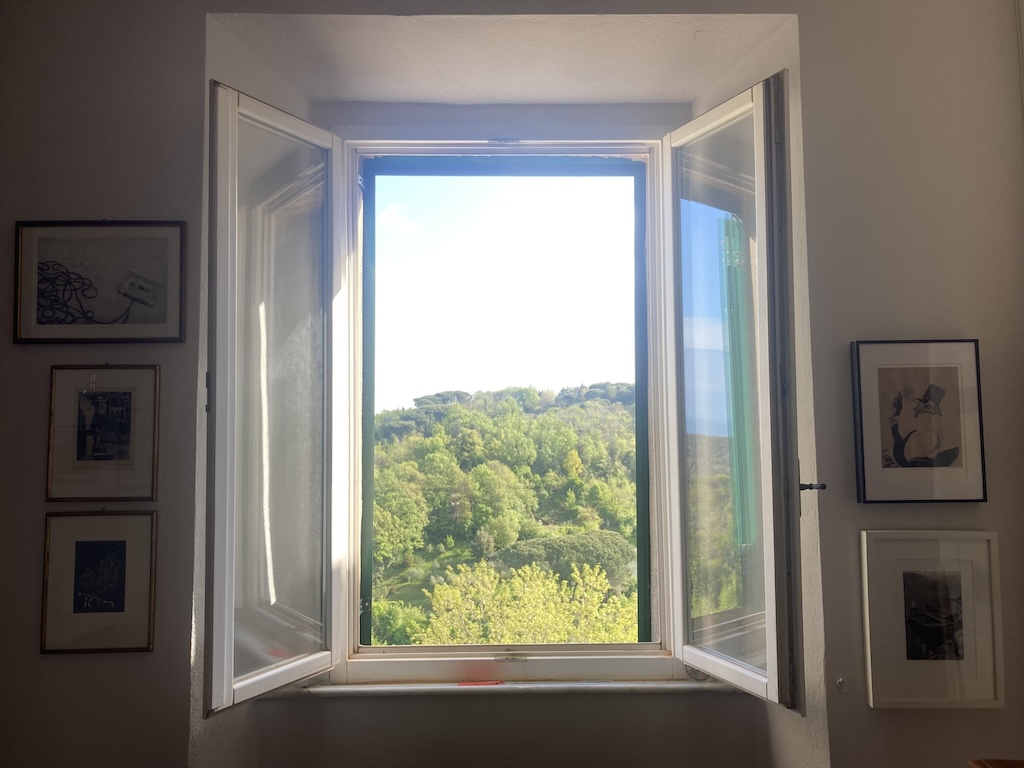
Once we were settled in the art-filled apartment, we enjoyed a lovely and relaxed supper, starting with a bicicletta, in Franco’s apartment across the hallway, sharing our stories, and talking about what we wanted to achieve during our week there.
A Day of Experiments
The next morning over breakfast Lisa, Lali and I decided to spend the first day getting the lay of the land. I was eager to get comfortable in the letterpress shop; Lisa and Lali wanted to experiment with more free-flowing printmaking.
Two Cents is more of a “campus” than a single print shop: below the apartments is the printmaking and photography workshop; about 5 minutes walk out the back door, and down a twisting labyrinth of cobbled alleys, is a spacious letterpress shop. We spent our time spread between the two.
Letterpress and Type
Franco is a prodigious collector of type, and the letterpress shop boasts a dreamy collection that I was eager to try out, so I set myself to experimenting.
I started out printing the word sulphur in appropriately sulphuric yellow, an homage to the area around Serrazzano having a faint sulphuric smell, given its geologic makeup that so lends itself to energy production.
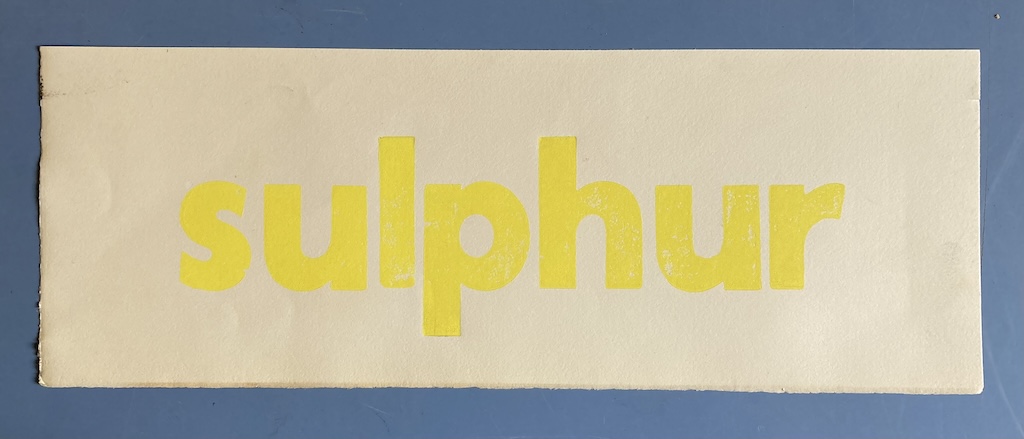
Next I experimented with a lovely reversed metal typeface to make some Serrazzano bookmarks:
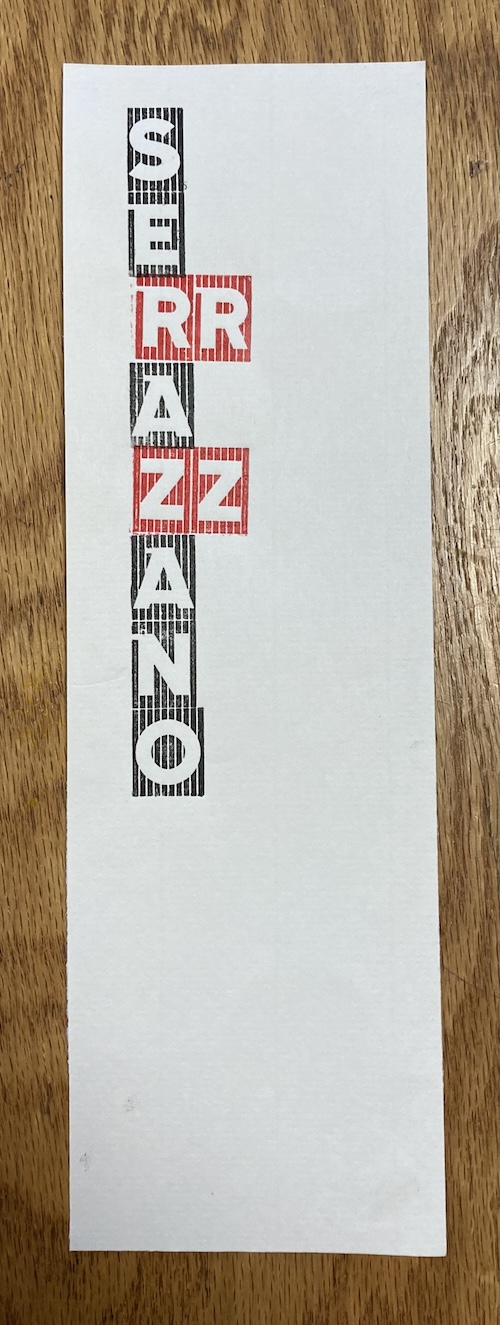
And then a larger-format pair of Serrazzano, printed with very large wood type, the first on paper and the second on some scrap linen:
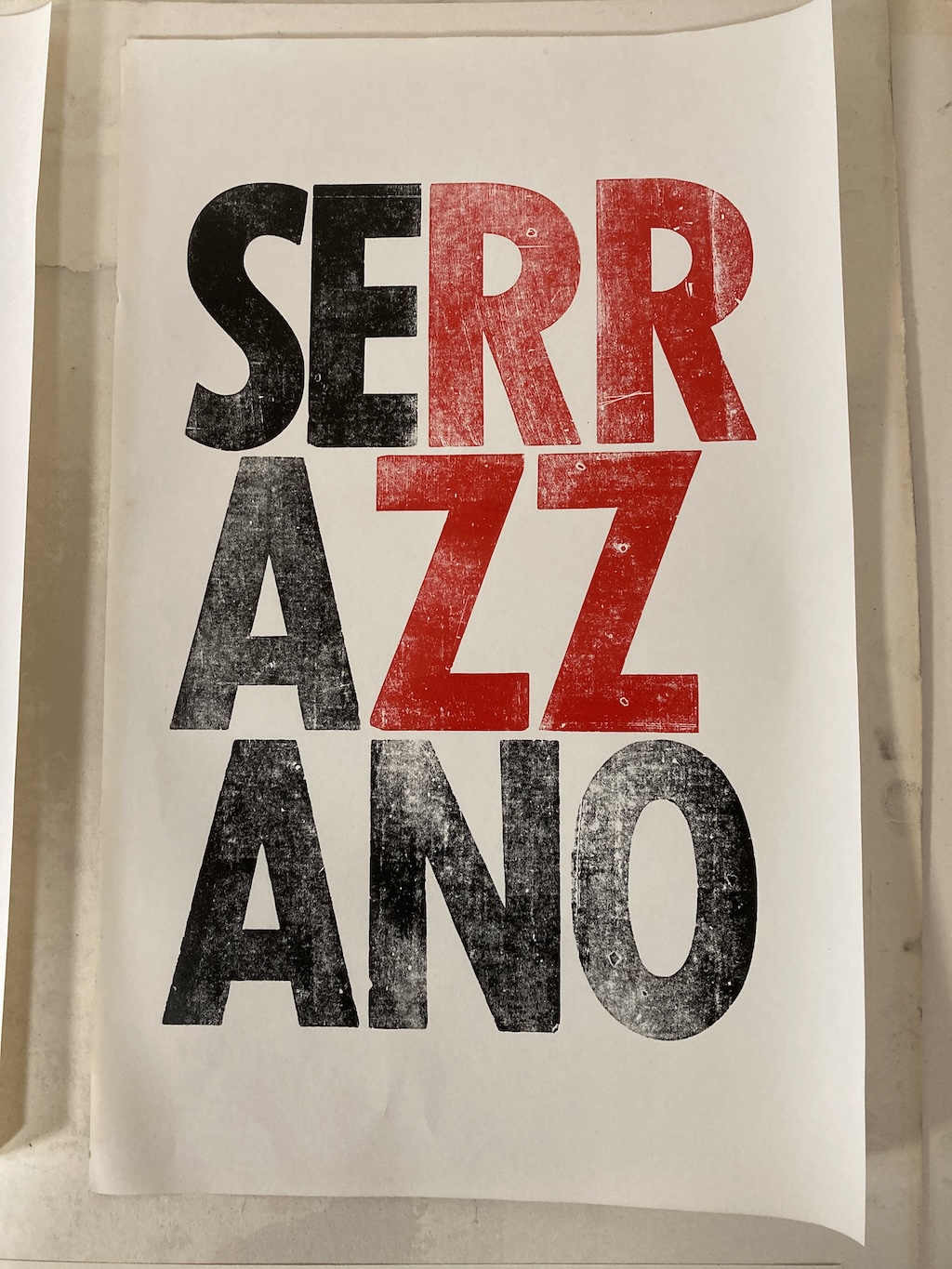
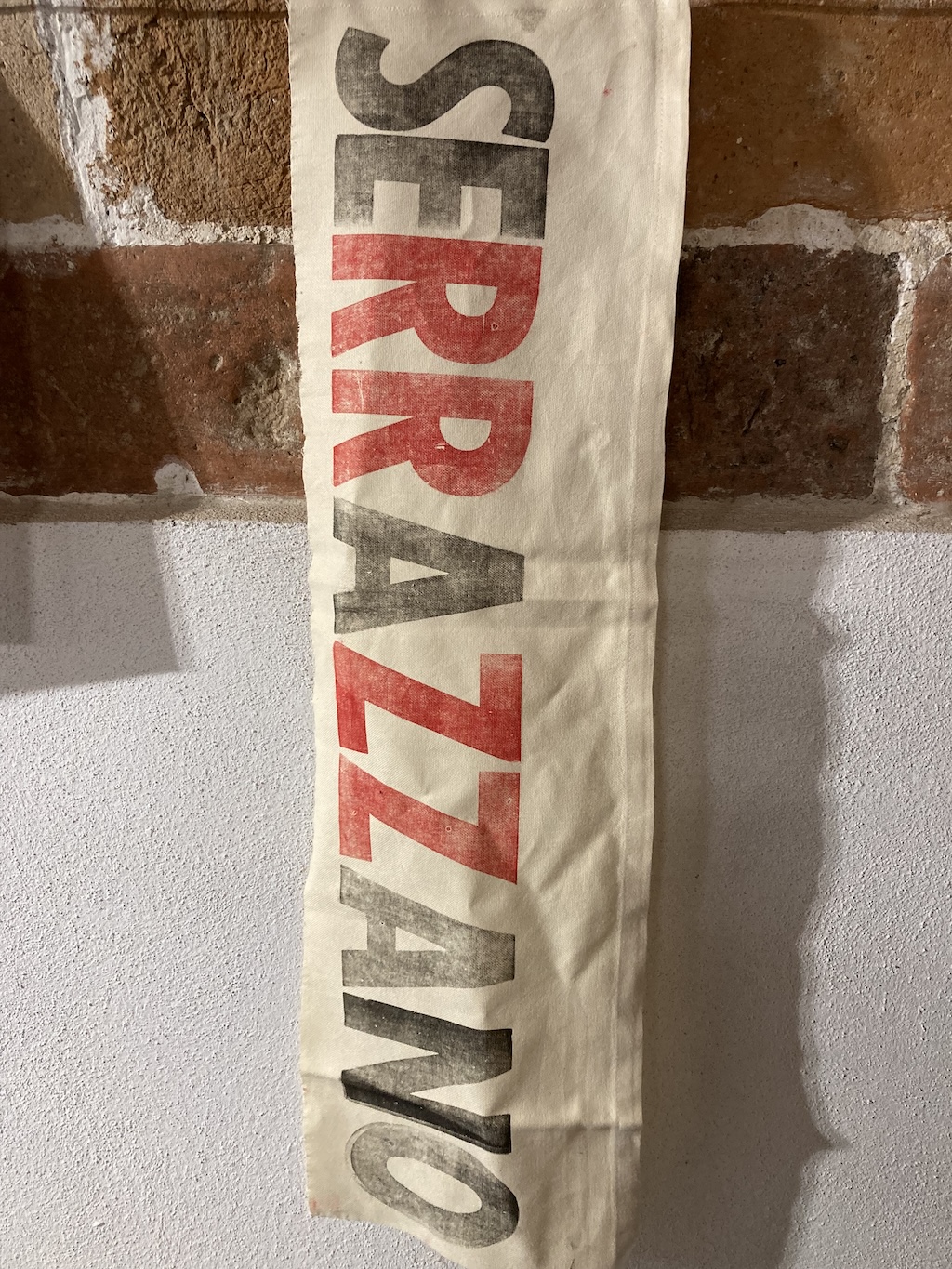
Printmaking
Meanwhile, in the printmaking workshop, Lali and Lisa were experimenting with less typographical printing:
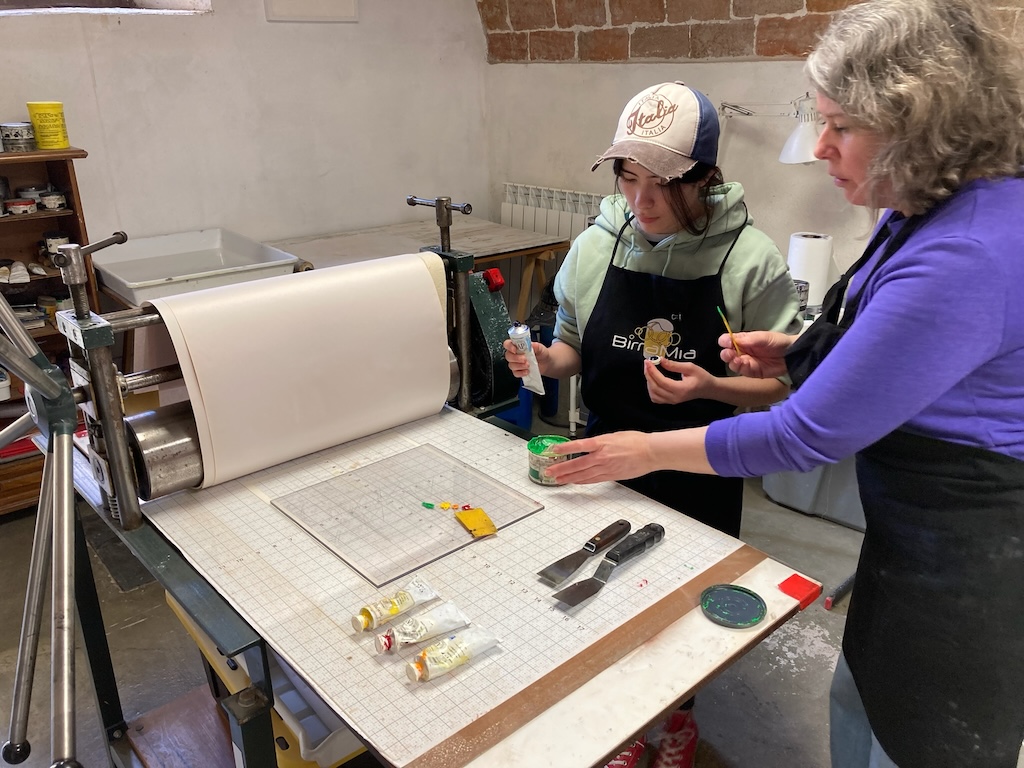
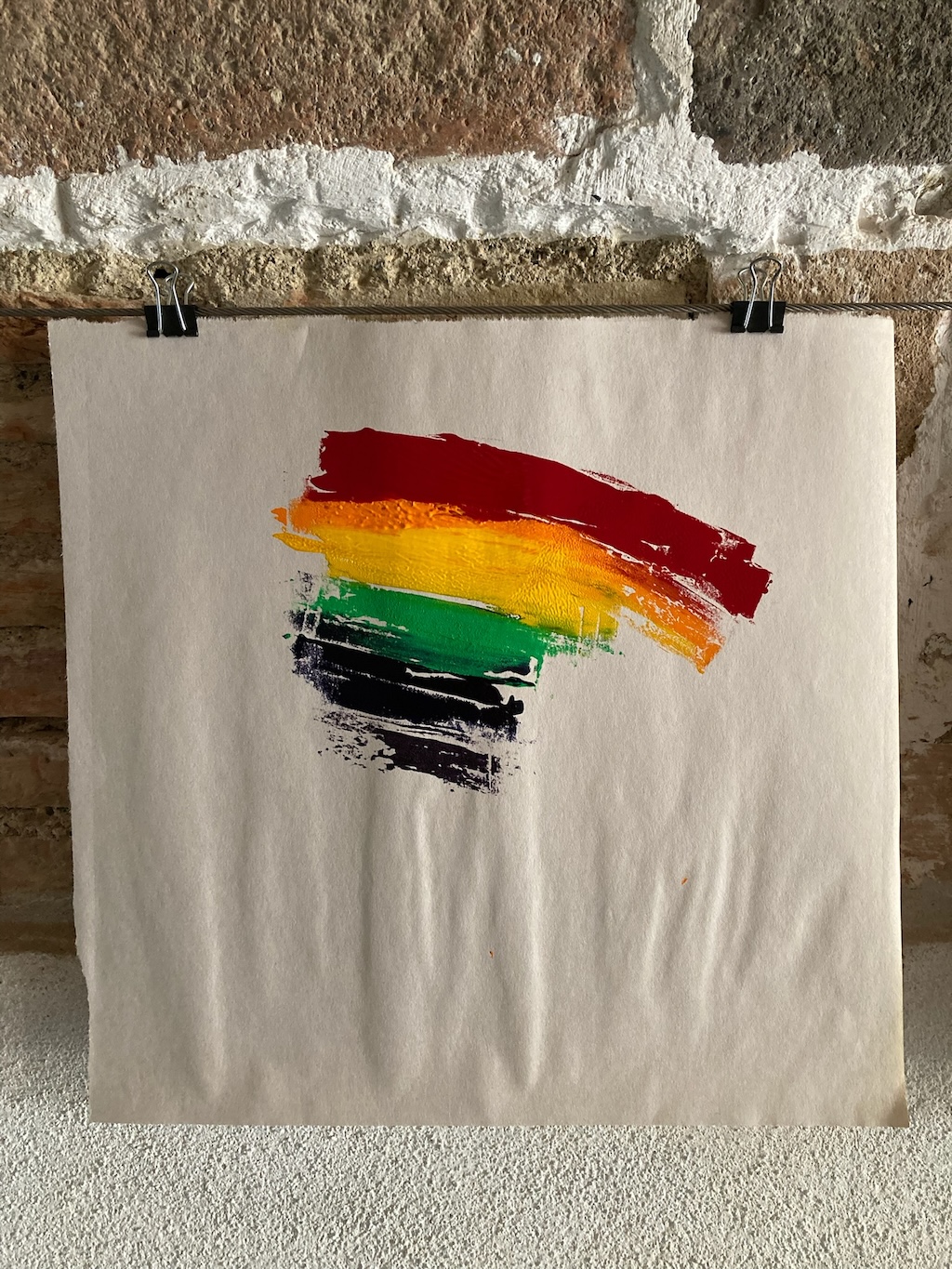
That final print presaged the direction for our Serrazzano This Box is for Good box: it was the first of Lisa’s experiments using local botanicals—leaves, shoots, flowers—to print with. Indeed she produced a prototype that morning that led the way:
Gathering the Botanicals
We caucused with Franco the next morning, and decided to pursue the botanical direction for the box. It was raining, but Lali, Lisa, and Franco gamely headed off into the lush green area surrounding the village, foraging greenery—things like olive and fig leaves—for printing.
(In the photo above, you can see their foraging grounds relative to the village above; the red door in the centre of the frame is the door to the letterpress shop.)
They returned with an excellent harvest to experiment with:
Lisa sorted and prepared the greenery for its next steps:
Making a “How To” Booklet
Meanwhile, I set out to make a booklet.
One of the aspects of This Box is for Good that we continue to refine (we might sometimes say “struggle with”) is how we explain the concept of receiving a box, and then passing it on to someone else. We’re getting better at this every month, and with Franco’s brainstorming help, we came up with the idea of including a “how to” booklet in the Serrazzano box, an opportunity experiment with translating a hand-drawn comic into a plate for printing on the letterpress.
So while botanicals were being gathered by the others, I set out to sketch, and came up with this:
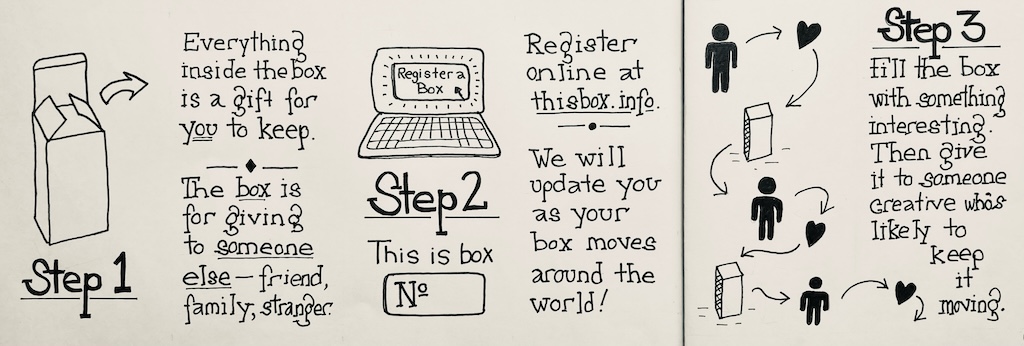
I sketched a design that could be folded five times to make an unfolding booklet that we could slip inside each box.
From my sketch, Franco made a digital scan, and then produced a negative:
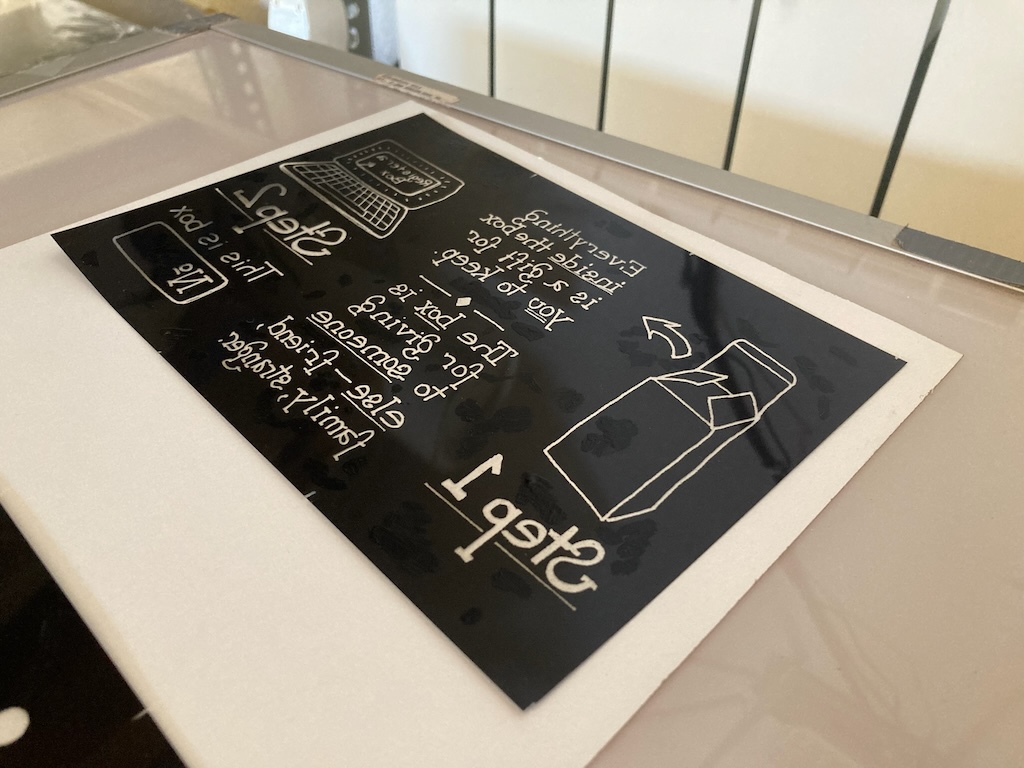
From the negative, he produced a polymer plate of the sketch, which could be mounted on a Boxcar Base (to make it type-high), and used to print on the letterpress:
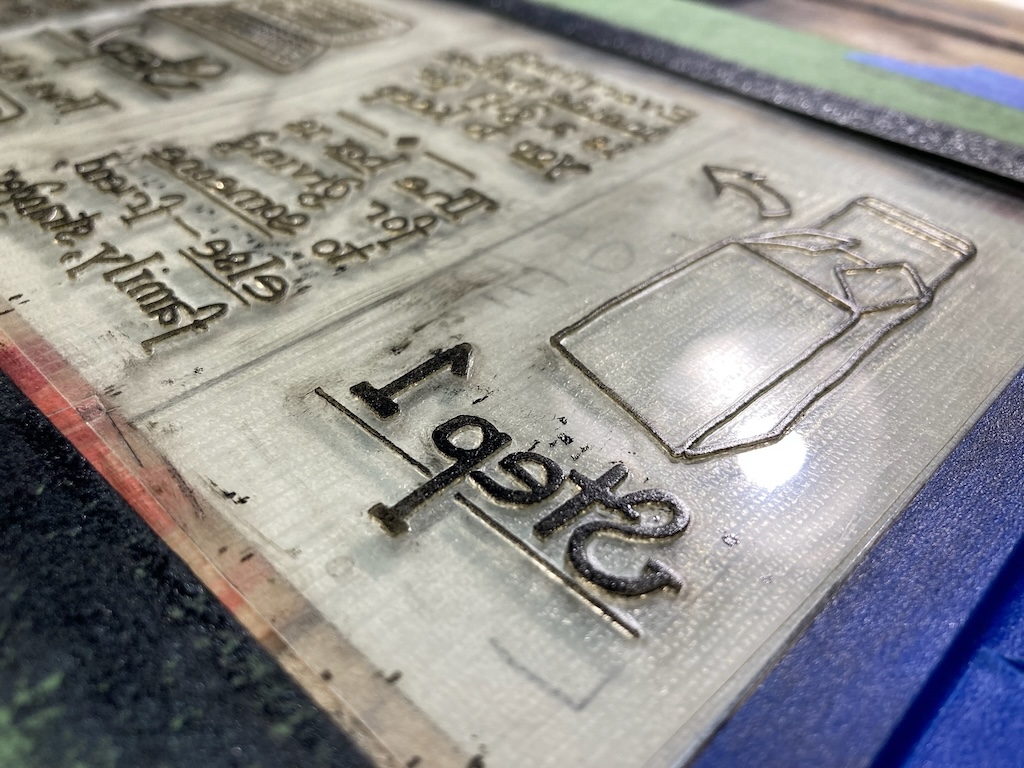
Franco had a ream or two of Magnani Pescia paper in the shop, paper produced at a mill in the village of Pescia, not far from Lucca, from 1404 until 2014, when circumstances, including a landslide on the road into the village, led to its untimely end.
Franco purchased this particular paper many years ago, from original stock, and so in addition to being otherworldly, it was also a relic of a 610 year old paper-making tradition.
It was lovely rag paper, so enormously satisfying to print with.
Hand-inking each impression was an exercise in patience, as I inevitably inked “empty” parts of the plate in error, and had to clean these mistakes up with Q-tips. Eventually I fashioned a crude set of “rails” that mitigated this.
Preparing the Botanicals
Lisa and Franco used a similar, albeit more complicated, platemaking process to prepare the botanicals for printing.
First, Lisa inked the botanicals directly with a brayer and black ink, making prints of each directly:
Next, Franco scanned the prints digitally, and then, much like he produced a negative for the booklet, produced negatives of the greenery in preparation for platemaking:
He then produced a polymer plate of each of the prints, which were dried and cured in the sun:
Once we had a plate ready, we made another prototype box, printing directly on the brown boxboard:
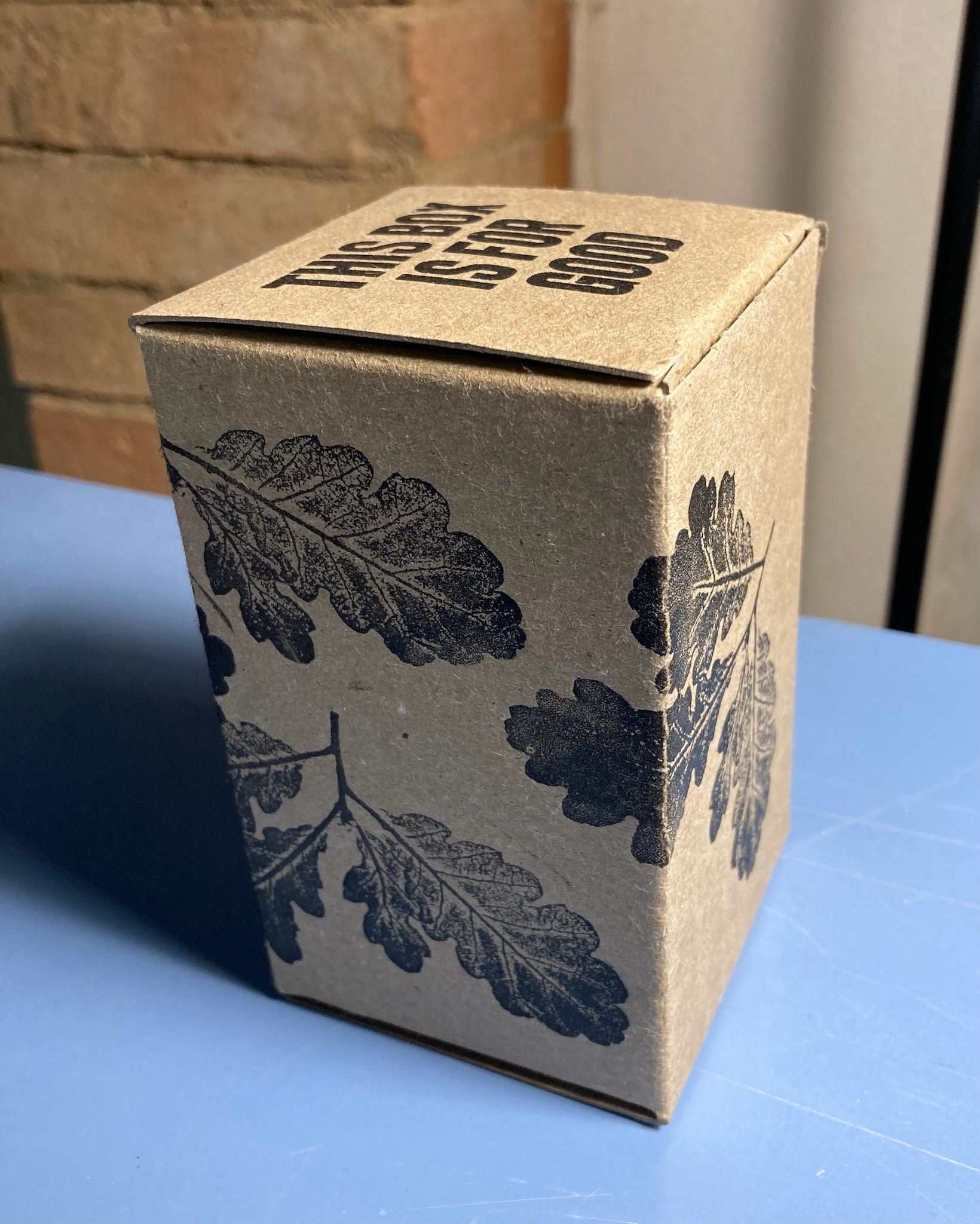
Printing Background Colours
One of the innovations in the box printing we executed in Europe was slicing the boxes apart to allow us to print all four sides of the box in a single go: for our earlier boxes, printed in Canada, we’d been printing only two sides at a time, as the boxes arrived folded and glued.
Starting in Hilversum we’d learned that carefully separating the glued seam would allow us to unfold the boxes and print a single print, with a single plate, which made the printing significantly easier and more flexible.
One of the things that Franco suggested early on, before we’d ever arrived in Serrazzano, was the idea of underprinting a solid colour on the boxes, to allow us to print on something other than “boxboard brown.” We decided to follow that suggestion for the botanicals boxes, and used to linoleum blocks to print a variety of solid colours on the boxes as a first step.
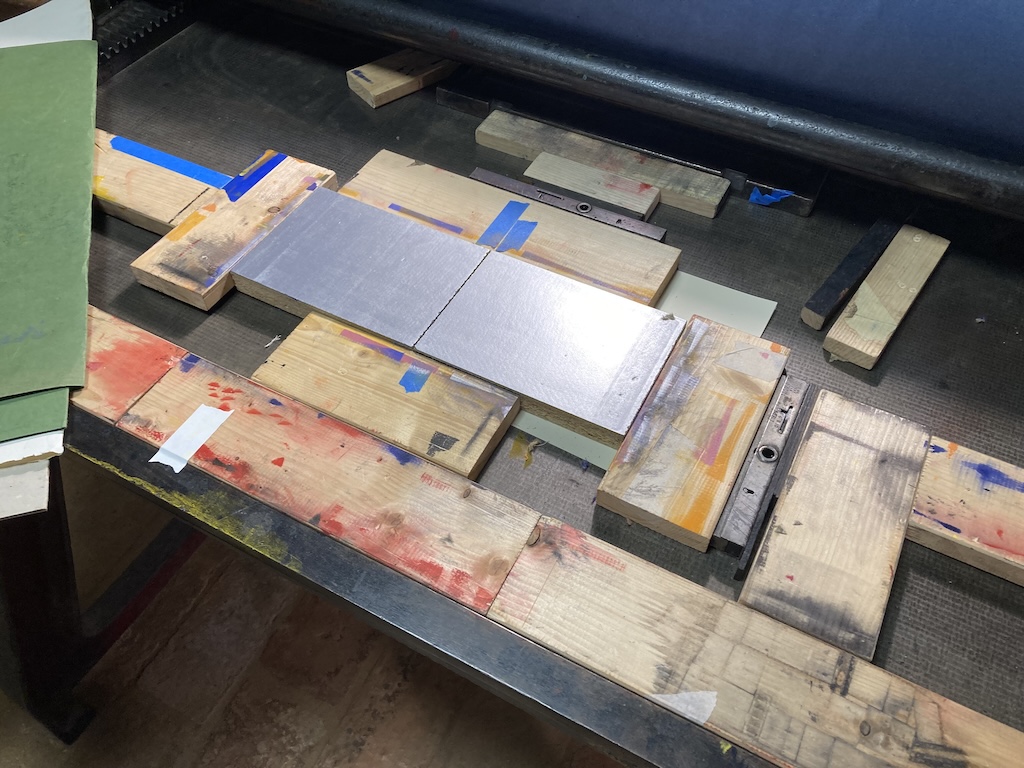
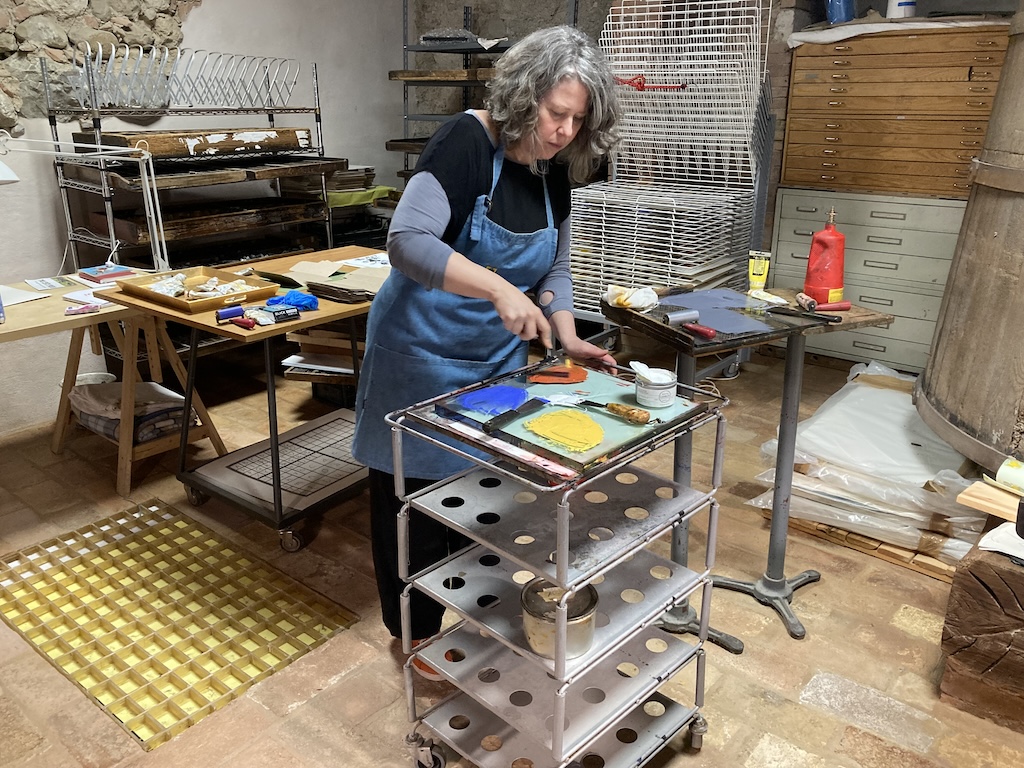
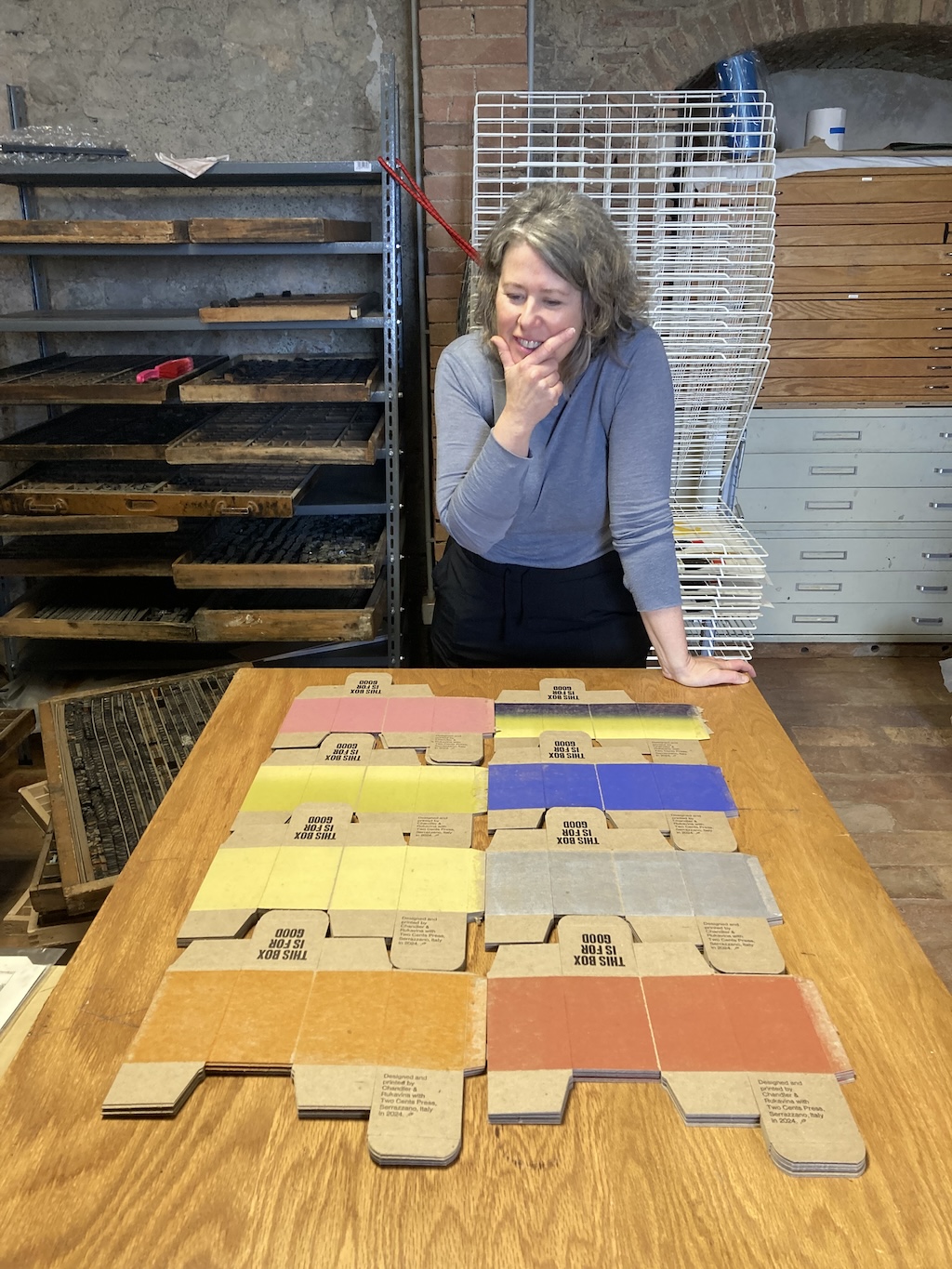
We ended up with a satisfying array of options for overprinting the botanicals, from silver to orange to rust to blue, with a couple of rainbow rolls thrown in for fun.
Printing the Botanicals
We started off the printing process by cutting up the polymers plates of the botanicals into individual elements, which we could position on the Boxcar Base with double-sided tape on the underside:
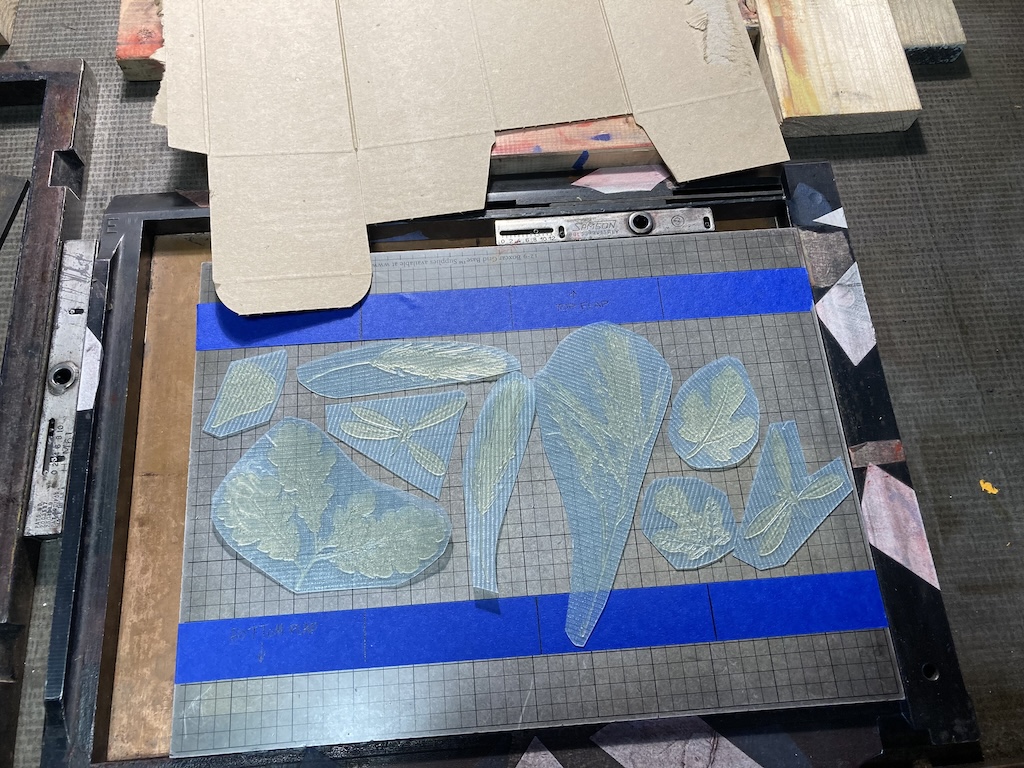
Lisa and I did a lot of experimenting with placement of the botanicals plates on the boxes: we packed them in tight, we changed their relative position, we left some out, included others. We finally decided that one leave or shoot per side was the most pleasing, and so that’s how we proceeded (with a small “coda” on the lid).
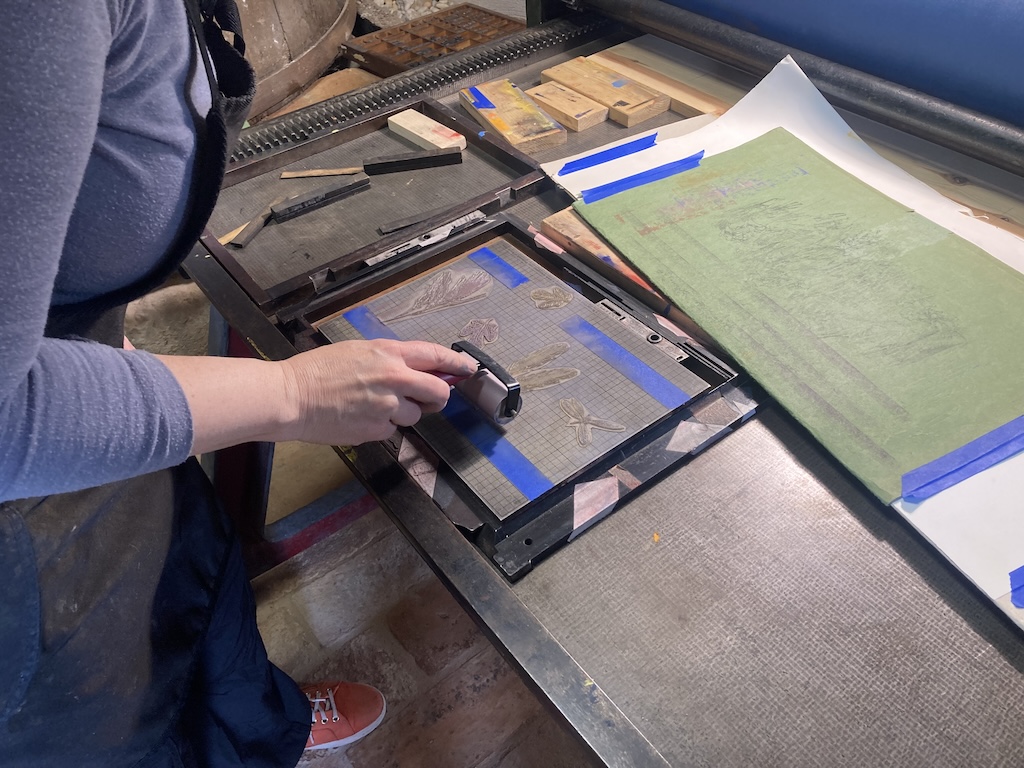
Because we were hand-inking the plates, for printing on the flatbed press (otherwise a chore compared the the automatic joy of a platen press, where the rollers automatically do this), we had the opportunity to more easily experiment with different ink colours for different backgrounds.
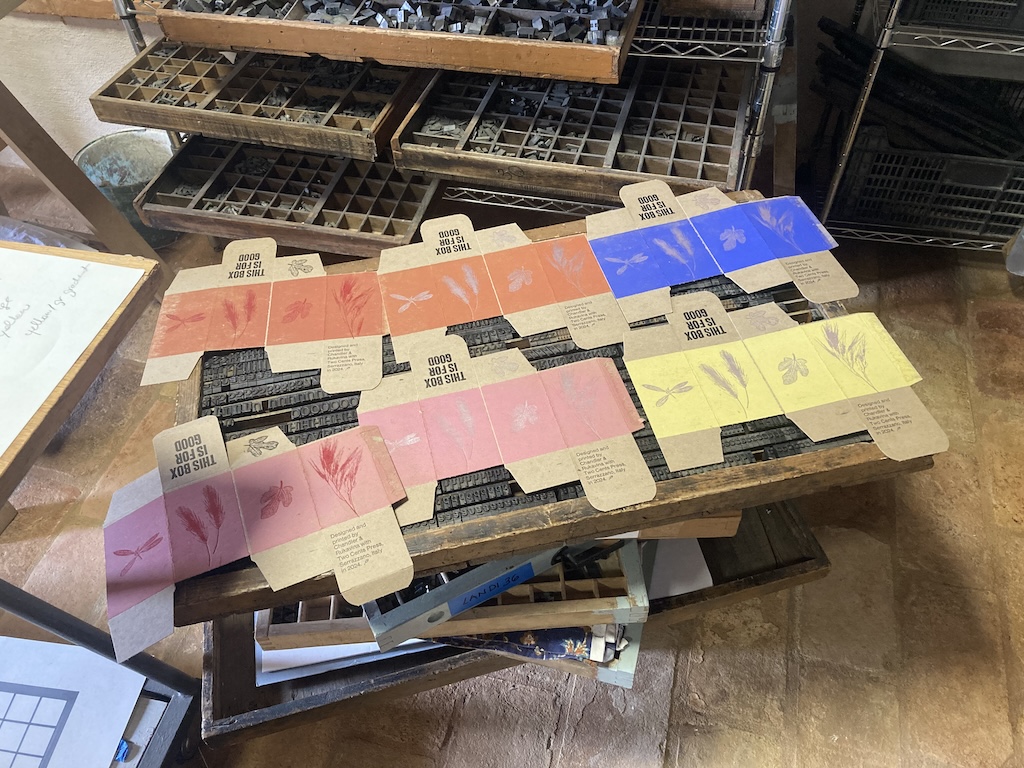
We were very pleased with the result (and remain a little bowled over when we think of the number of steps it took to get us from concept to finished boxes).
Stretch Goal: Cards
Every month we seek to also put something inside each box, a keepsake gift that the recipient of the box, from us, can keep before refilling the box and passing it along.
In Serrazzano we decided, on the second-last day, once the boxes were done and dusted, to print small business card-sized cards. Lali and Lisa took on this project, printing not from polymer plates, but inking botanicals directly, a messy, fascinating, sometimes confounding process that offered a lot of opportunity for experimentation:
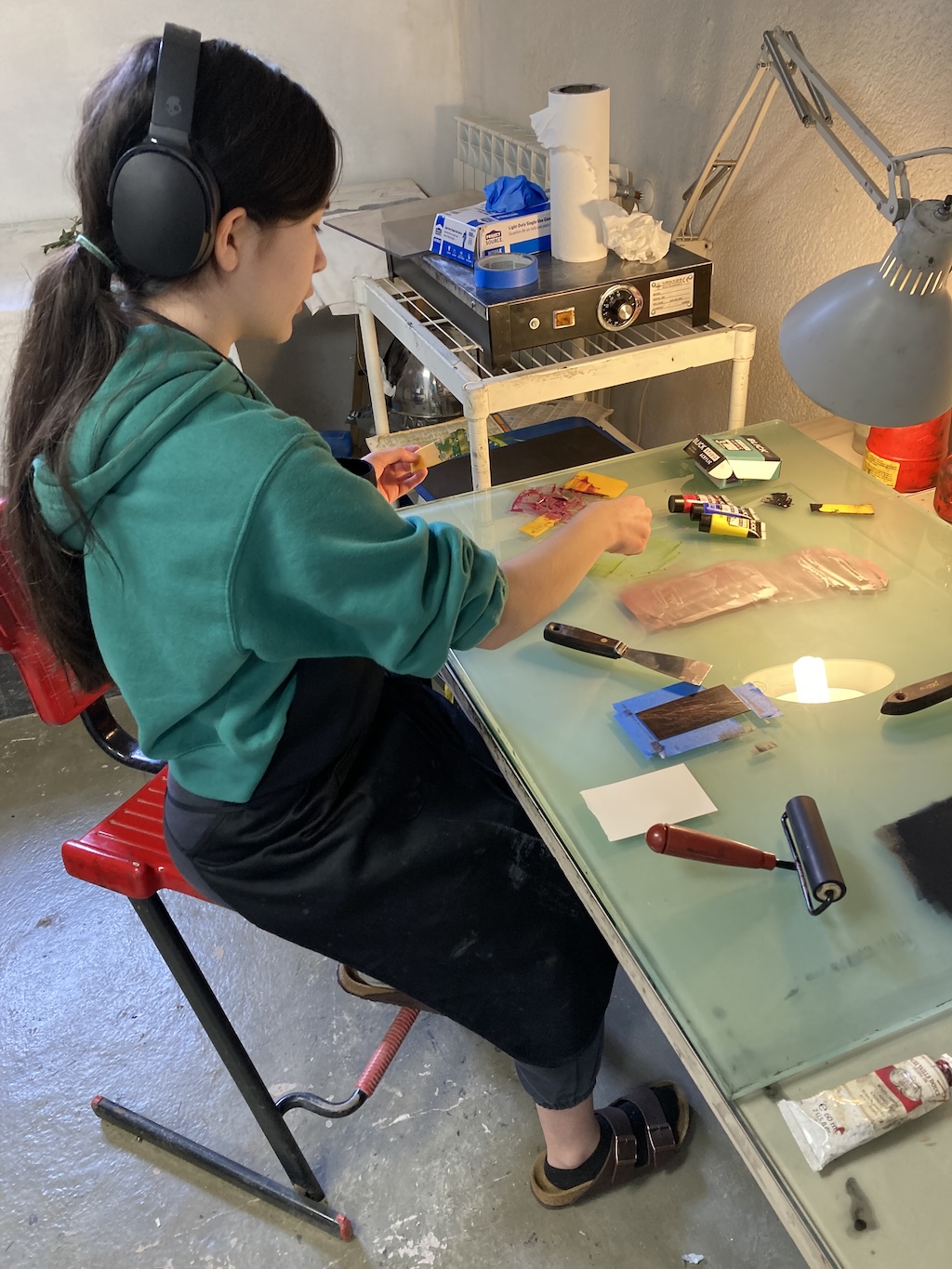
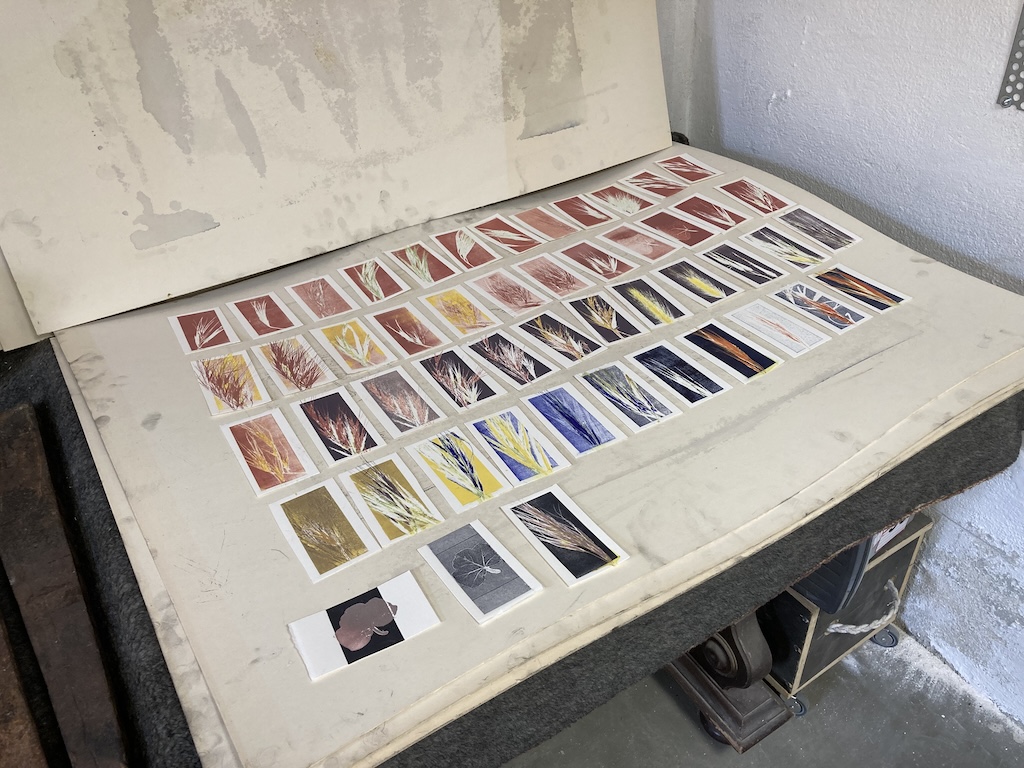
Fumbling Toward the Finish Line
With the boxes printed and dried, the bookmarks printed and dried, the booklets printed, dried, and folded, on the last morning of our residency we frantically rushed to the finish line.
This is where things went off the rails.
In retrospect, in addition to all of the above, which was experimental and educational and fun, we realize that what we’d also done was turn a lovely five day stay in an idyllic Tuscan village into a job, and a frantic one at that, filled late nights, and lack of spaciousness, with little opportunity to let the environment sink in.
This all came to a head on that last morning, when Lisa and I got into an argument, right in the middle of rushing to tie up all the loose ends, something made both more fraught and more delightful by being pulled away by Franco for a must-see village singing tradition halfway through.
We repaired the damage and forgave each other, but it stung, for both of us, and made us realize that, next time, we should leave more air in the schedule, more time to connect. And that we should focus on the collaboration, not the task list, as the preeminent metric for success.
We did get to the finish line, however. We labelled, folded, and glued the boxes. We glued small “booklet holding straps” into each box. Installed the booklets. Put a card in each one. Sorted which boxes to leave with Franco for distribution to future residents, and which to take on the road with us.
We were due to leave at 12 Noon, and about 12:25 p.m. we were on our way out the door, finishing up with gifting a special box to Franco in thanks for, well, everything.
Where The Boxes Went
We ended up with 35 printed and packed boxes in total. Here’s where we distributed them:
- We left 10 boxes with Franco for future printmakers resident at Two Cents Press.
- We left 9 boxes at Paradiso 518, the book and magazine shop in Perugia we visited a week later.
- We left a box for our Airbnb host in Gubbio, another for a friendly shopkeeping family there, and another for a couple we met at the Roman ruins in the town.
- We gave three boxes to the friendly staff at the paper and watermark museum in Fabriano.
- We mailed 10 boxes to a combination of European family, friends and people we’d encountered along the way.
- We left a box at Emilia, a lovely restaurant in Portonovo, on the Adriatic coast.
- We left a box at the Airbnb we stayed at in Numana, also on the Adriatic coast.
Of the 35 boxes we distributed, 8 have been registered as of this writing.
Where This Box Has Been
11 boxes with 22 registrations across 20 unique locations:
| Box Number | Registrations | Journey |
|---|---|---|
| 534 | 4 | Ancona, Italy → Ancona, Italy → Monzuno, Italy → Milano, Italy |
| 536 | 4 | Firenze, Italy → Jerusalem, Israel → Haris, Salfit, Palestinian Territories → Haris, Salfit, Palestinian Territories, Palestinian Territories |
| 526 | 3 | Frederiksberg, Denmark → Zurich, Switzerland → Zürich, Switzerland |
| 501 | 2 | Cambridge, New Zealand → Hamilton, New Zealand |
| 503 | 2 | Turku, Finland → Västanfjärd, Finland |
| 509 | 2 | Kópavogur, Iceland → Kópavogur, Iceland |
| 517 | 1 | Roma , Italy |
| 524 | 1 | Braemar Scotland, United Kingdom |
| 525 | 1 | Siena, Italy |
| 532 | 1 | Berlin, Germany |
| 539 | 1 | Saronno, Italy |
